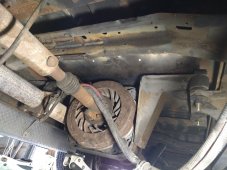Thomas Barlow
New Member
- Joined
- Nov 22, 2020
- Messages
- 6
Hey what's up guys I came up with this crazy idea the other day. So my rig is a 2001 e450 shuttle bus with the 7.3 powerstroke. I bought it for $2,700 a couple years ago and it has been the best purchase I ever made.
I lucked out and it came with a electromagnetic drive shaft break called a Telma which essentially allows the first 25% of my stopping power to be done via frictionless magnetic eddy currents in these big steel spinny disks on the driveshaft.
It works really really well and got me thinking instead of drawing 150 amps from the alternator to power the Telma what if there was a way to attach an "alternator/ 12v generator" to the drive shaft but was only applied load "charges" when you press the brakes.
I'm thinking a Ford alternator only requires a 12 volt reference signal and if you were to connect that to the truck's brake lights it would only be charging while you're on the brakes.
I'm going to attempt to retrofit a 200 amp truck alternator onto the drive shaft so every time I am slowing down for a red light or whatever i am charging a full 200amps into my lifePo4 batteries
Seems like free juice to me.
What do you guys think because my 1260 Watts on the roof is not cutting it.
Attached are pics of the Telma Brake.
I lucked out and it came with a electromagnetic drive shaft break called a Telma which essentially allows the first 25% of my stopping power to be done via frictionless magnetic eddy currents in these big steel spinny disks on the driveshaft.
It works really really well and got me thinking instead of drawing 150 amps from the alternator to power the Telma what if there was a way to attach an "alternator/ 12v generator" to the drive shaft but was only applied load "charges" when you press the brakes.
I'm thinking a Ford alternator only requires a 12 volt reference signal and if you were to connect that to the truck's brake lights it would only be charging while you're on the brakes.
I'm going to attempt to retrofit a 200 amp truck alternator onto the drive shaft so every time I am slowing down for a red light or whatever i am charging a full 200amps into my lifePo4 batteries
Seems like free juice to me.
What do you guys think because my 1260 Watts on the roof is not cutting it.
Attached are pics of the Telma Brake.




